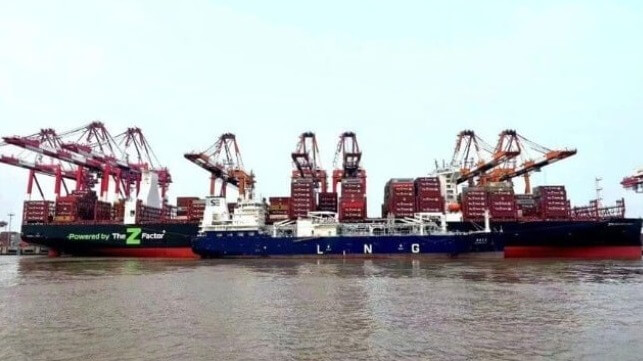Record Number of Methanol-Fueled Ships Ordered Reports DNV

After a slow start to 2023 for orders of alternatively fueled ships, DNV is reporting the momentum generated in 2022 resulted in a record order of dual-fuel methanol ships as well as strong growth for LNG-fueled orders in February. DNV had predicted that 2023 was likely to follow a similar pattern as 2022 with orders coming in various sectors as demand builds for new ships.
“Alternative fuels came back with a bang in February!,” writes DNV Principal Consultant Martin Wold in a social media posting today. This came after he previously noted a slow start to 2023. However, at the time, he said February was looking exciting with strong prospects in the alternative fuel sector.
While construction orders overall slowed in 2022, the alternative fuel portion remained at a consistent pace with 2021. DNV calculated that the breakdown in the 2022 orderbook for alternative fuels showed that 81 percent of all ships with alternative fuels ordered last year were with LNG or a total of 222 ships ordered. Methanol was the second most popular alternative fuel choice in 2022, with 35 ships ordered or 13 percent of the total orders placed.
“It was methanol that stole the spotlight last month, with a record 22(!) ships ordered/confirmed,” writes Wold today discussing the rebound in February. The big news in the sector came from HMM, which ordered nine 9,000 TEU containerships to be built in South Korea. While not publicly detailing their orders, CMA CGM and MSC also joined the growing number of ships to be built with dual-fuel methanol propulsion plants.
The French shipping company, which until now has been investing mostly in LNG-fueled ships, placed an order that was valued at over $2 billion for a dozen 13,000 TEU container vessels to be built by Hyundai in South Korea. It followed a smaller order CMA CGM made in 2022 for its first methanol-powered vessels. MSC also jumped in with an order reportedly valued at $1.2 billion for methanol-ready boxships.
“With that, methanol passed the 100 ship mark,” writes Wold. DNV’s Alternative Fuels Insights data shows that there are currently 25 methanol-fueled vessels in service, almost entirely tankers. The orders however are quickly building in the containership category with it now up to 68 ships according to DNV. They calculate that there are a total of 81 methanol-fueled ships on order for delivery by 2028.
The momentum for methanol continues to grow. Earlier this week, Norwegian Cruise Line announced that it was altering the design of two cruise ships ordered from Fincantieri to begin the process to make the ships methanol-ready. The cruise company had previously said it was considering adding methanol fuel tanks to some of its ships while it is also working with MAN on a project to develop engine retrofits for the alternative fuel.
Methanol, Wold noted, had established itself as an alternative in 2022. He cites the cost advantages and ease of installing methanol systems for shipbuilders noting that engine manufacturers report high interest in methanol-capable engines. At year’s end, Wold had said DNV believes concerns about sourcing and near-term scalability of green methanol are the main factors slowing its adoption while predicting strong future growth.

that matters most
Get the latest maritime news delivered to your inbox daily.
While the next generation of alternative fuel is drawing attention, LNG however continues to maintain a strong lead in the near term. Wold notes that DNV recorded 10 new LNG-fueled orders in February. That pushes the total LNG orderbook to well over 500 ships due by 2028. DNV calculates there will be 886 LNG-fueled ships when these orders are delivered.
More than one in five of the orders placed for newbuilds in 2023 is for one of the forms of alternative fuels according to DNV’s data. While it is early in the year, the pace is well ahead of the just under 15 percent achieved for alternative fuels in 2022. The challenge however remains that all forms of alternative fuels represent just half a percent of the global fleet. By 2028, DNV reports however that the number will have risen to over 1,100 alternatively fueled ships in service with the momentum expected to continue to grow.
